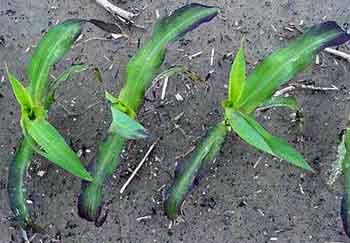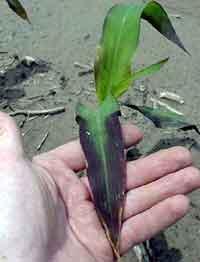Soils
Why is my young corn stunted and purple?

Phosphorus's primary role in a plant is to store and transfer energy produced by photosynthesis for use in growth and reproductive processes. Adequate phosphorus levels encourage vigorous root and shoot growth and promote early maturity. These effects often increase water use efficiency and potential grain yield. Thus, phosphorus deficiency stunts plant vegetative growth and grain development.
Purple leaf tissue is symptomatic of phosphorus deficiency. Phosphorus deficiency symptoms appear on lower leaf tips and progress along leaf margins until the entire leaf shows purpling. Lower leaves often die when phosphorus deficiency is severe, especially when hot, dry, windy conditions persist. New leaves emerging from the whorl are usually green, because the plant mobilizes available phosphorus to the youngest leaves.

Leaves normally regain green coloration when further root exploration occurs, especially when favorable growing conditions prevail. However, phosphorus deficiency will reduce yield by delaying maturity, stunting growth, and restricting energy utilization.
Treatment options to remedy phosphorus deficiency have modest short-term effectiveness, since phosphorus is immobile in the soil solution. Thus, root exploration into the amended area is required for plant uptake. Surface application of phosphorus fertilizer will limit availability to the top couple inches of soil. Thus, plant uptake would be more probable in irrigated and/or no-tillage cropping systems, since these systems encourage root exploration near the soil surface. Phosphorus injected as a side-dress treatment would increase availability to the root system, however, be careful not to prune roots.